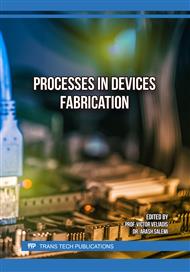[1]
Kimoto, T.; Cooper, J.A. Fundamentals of Silicon Carbide Technology, 1st ed.; John Wiley & Sons: Singapore, 2014.
Google Scholar
[2]
Roccaforte, F.; Fiorenza, P.; Greco, G.; Lo Nigro, R.; Giannazzo, F.; Patti, A.; Saggio, M. Challenges for energy efficient wide band gap semiconductor power devices. Phys. Status Solidi A 2014, 211, 2063–2071.
DOI: 10.1002/pssa.201300558
Google Scholar
[3]
Z. Wang, S. Tsukimoto, M. Saito and Y. Ikuhara; Introducing Ohmic Contacts into Silicon Carbide Technology; WPI Research Center, Advanced Institute for Materials Research, Tohoku University 2-1-1 Katahira, Aoba-ku, Japan Silicon Carbide – Materials, Processing and Applications in Electronic Devices
DOI: 10.5772/20481
Google Scholar
[4]
Kimoto, T. Material science and device physics in SiC technology for high-voltage power devices. Jpn. J. Appl. Phys. 2015, 54, 040103.
DOI: 10.7567/jjap.54.040103
Google Scholar
[5]
She, X.; Huang, A.Q.; Lucía, Ó.; Ozpineci, B. Review of silicon carbide power devices and their applications. IEEE Trans. Ind. Electron. 2017, 64, 8193–8205.
DOI: 10.1109/tie.2017.2652401
Google Scholar
[6]
F. Roccaforte, G. Brezeanu, P.M. Gammon, F. Giannazzo, S. Rascunà, M. Saggio, Schottky contacts to silicon carbide: physics, technology and applications, in "Advancing Silicon Carbide Electronics Technology vol. I", Mater. Res. Found. 37(2018) 127–190
DOI: 10.21741/9781945291852-3
Google Scholar
[7]
F. Roccaforte, F.Fiorenza, P.Vivona, M.; Greco, G.; Giannazzo, Selective Doping in Silicon Carbide Power Devices. Materials 2021, 14, 3923
DOI: 10.3390/ma14143923
Google Scholar
[8]
L.M. Porter, R.F. Davis: Mater. Sci. Eng. B 34, 83 (1995)
Google Scholar
[9]
J. Crofton, L.M. Porter, J.R. Williams: phys. stat. sol. (a) 202, 581 (1997)
Google Scholar
[10]
M.J. Bozack: phys. stat. sol. (a) 202, 549 (1997)
Google Scholar
[11]
S.W. King, R.J. Nemanich and R.F. Davis: J. Electrochem. Soc. 146, 2648 (1999)
Google Scholar
[12]
L. Muehlhoff, W.J. Choike, M.J. Bozack, J.T. Yates, Jr.: J. Appl. Phys. 60,2842 (1986))
Google Scholar
[13]
R.J. Trew: phys. stat. sol. (a) 162, 409 (1997)
Google Scholar


